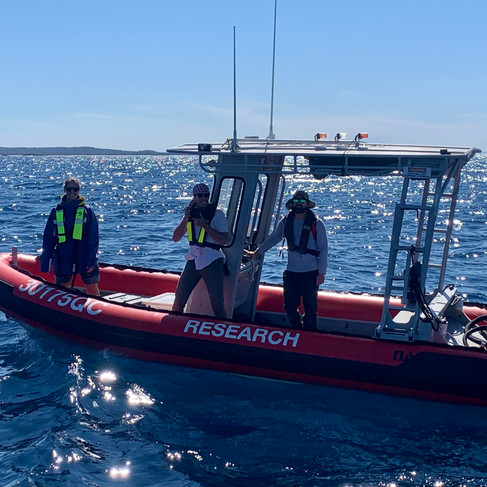Heading East to HIMB
- MMRP
- Oct 31, 2024
- 5 min read
Written by MMRP PostDoc Jake Linsky
My philosophy career was derailed somewhere between the sea lions in California and pods of competitive humpback whales in Queensland’s crystal waters. As an undergraduate at UC Santa Cruz, my priorities firmly rested in surfing and catching the next Dead concert. Needless to say, research wasn’t really on my radar. I did, however, have a keen interest in language cognition and the workings of the animal mind. As my philosophy degree progressed, I was increasingly exposed to Frege, Wittgenstein, and Chomsky and found myself gravitating towards the exciting but frustratingly convoluted field of language cognition. One afternoon, noshing on a kebab, I decided it was time for me to jump fields and engage in the sciences. An intensive two minutes of online research revealed that UC Santa Cruz did, in fact, have a cognition lab with remarkable parallels to my interests. The only odd thing was they worked with pinnipeds.
Before I discovered my passion for research, I had a penchant for being in the ocean and nerding about music.
For the next five years I spent all the time I could, from random Wednesdays to Christmas, learning from these wonderful, albeit demonstrably strange, marine mammals. The Pinniped Cognition and Sensory Systems Laboratory provided a diverse environment where I was exposed to everything from animal training and husbandry to structured behavioral experiments and the unpredictable conditions of fieldwork along California's rugged coastline. Here, I made my first foray into research, designing and training a music cognition experiment with Ronan, an immensely bright and hard-working sea lion with a remarkable talent for finding rhythm in music. As the years passed, my appreciation for the animals I worked with deepened, and my curiosity expanded to understanding the extreme challenges their wild counterparts faced in our rapidly changing oceans. One of my mentors at the lab, Caroline Casey, had extensive fieldwork experience, including saving my skin from a 5,000-pound elephant seal while I was occupied weighing pups, as well as a deep knowledge of animal hearing and physiology in rapidly changing Arctic environments. My growing interest in Caroline’s areas of expertise drove me to approach her about opportunities to branch out into new areas of research.

Spending quality time with Ronan, from whom I’ve learned a lot about how animals perceive music and what conservation efforts stand to protect.
She advised me to contact a whale researcher -her future husband and research partner- Ari Friedlaender, who had recently moved the Biotelemetry and Behavioral Ecology Lab out to the UCSC coastal campus. Taking her advice turned out to be among the best decisions I ever made, as the experiences and support I gained in the Friedlaender lab kickstarted my career as a researcher. Ari connected me with Dave Cade, who was then completing a PhD on rorqual foraging kinematics at Stanford’s Goldbogen lab. As a mentor, Dave cultivated my excitement in ecology and kinematics by teaching me how to quantify features of whale foraging behavior, for example the time it takes for a whale to lunge and gulp down a patch of plankton, using cutting-edge video tags. After months of auditing video footage, my excitement didn’t wane, and Dave invited me to join him on the water to study blue whales off the Big Sur coastline. He handed me a biopsy crossbow, and we set off. My job was to collect a pinky-sized sample of blubber for a whale pregnancy test, while driver James Fahlbusch skillfully navigated around the massive animals and Dave placed suction cup tags on them to record their mouth movements while feeding. When Dave stuck the first tag on, I steadied myself, aimed… and missed a target the size of a barn door, in what remains the most embarrassing moment of my fieldwork career.
Luckily, however, Ari and Dave continued to give me opportunities to grow and improve in the field. Throughout 2019 I bounced between working with minke whales in the Antarctic at UCSC, and fur seals in the Pribilof islands with NOAA’s marine mammal lab. Having committed fully to becoming a researcher, I made the biggest leap of my career to date and began a PhD investigating the population health of the eastern Australian humpback whale with Rebecca Dunlop and Michael Noad at the University of Queensland in Australia.
Working from the US Antarctic program’s RV Laurence M. Gould was one of the highlights of my career. We tagged minke whales throughout the coastal bays of the West Antarctic Peninsula, and bumped into a range of wildlife, including this crabeater seal that seemed to have wriggled away from a leopard seal bite to its rear flippers. Throughout the trip, the minkes did a fair amount of research on us too!
Working with the fantastic team out at UQ’s Moreton Bay Research Station, I led a group of students and volunteers to collect small tissue samples and drone photographs from individual whales off Minjerribah. Luckily, my aim had improved significantly since my first biopsy mishap. The initial plan for our study was to measure only steroid hormones from the tissue, but I quickly realized that a narrow set of hormone levels alone doesn’t provide enough nuance to fully understand an animal’s health. To address this information gap, I incorporated an extensive gene expression study into my PhD, and was fortunate to have bat expert and genetics guru Lee McMichael join my supervisory team and show me the ropes of molecular science.
I was lucky to have an awesome team working off Minjerribah during my PhD. A successful day in the field is as good as it gets!
In 2020, the global pandemic nearly spelled disaster for my project. However, thanks to the support of the station staff, generous funders, and my supervisory team, I managed to get into the field throughout the impacted period and made an intriguing discovery: the whales' stress hormones and gene expression showed significant changes between 2020 and 2021. As it goes in science, I ended up with more questions than answers. Were these changes driven by natural fluctuations in the ENSO cycle, by the population nearing carrying capacity, by shifts in human activity during the pandemic (such as vessel traffic or pollution), or, perhaps most likely, by some combination of all these factors? However, this study taught me one clear lesson: nothing happens in isolation. Even animals in the most remote and polar environments can feel the ripples of change.

The eastern Australian humpback whale has rebounded from commercial whaling despite a range of stressors being present throughout their recovery. Today, questions remain about whether this adaptability is enough for their continued success in a rapidly changing environment. (photo taken under permit with the University of Queensland’s Cetacean Ecology Group)
Through my postdoctoral work in the Marine Mammal Research Program and the Madin Lab at the University of Hawai’i, I am developing methodologies to test theories about how changes to the environment impact marine mammals on a global scale. Specifically, I am working on automating whale detection from satellite imagery and turning those satellite whale counts into full-fledged population estimates. By assessing the abundance of individuals in remote populations, we will be better positioned to identify population declines early, and more effectively manage free-ranging whale populations in far-flung seas. As excited as I am about the research, one of the greatest perks is joining the lab community on Moku o Lo’e. The opportunity to work with this dedicated group of researchers is a dream, and I look forward to continuing to study our oceans alongside my friends from California, Will and Kirby, while also forming new connections with the talented and welcoming lab groups that Lars and Liz have built. The more we learn about our oceans, the more we realize how much remains to be discovered. I look forward to uncovering these secrets with you!




















Comments